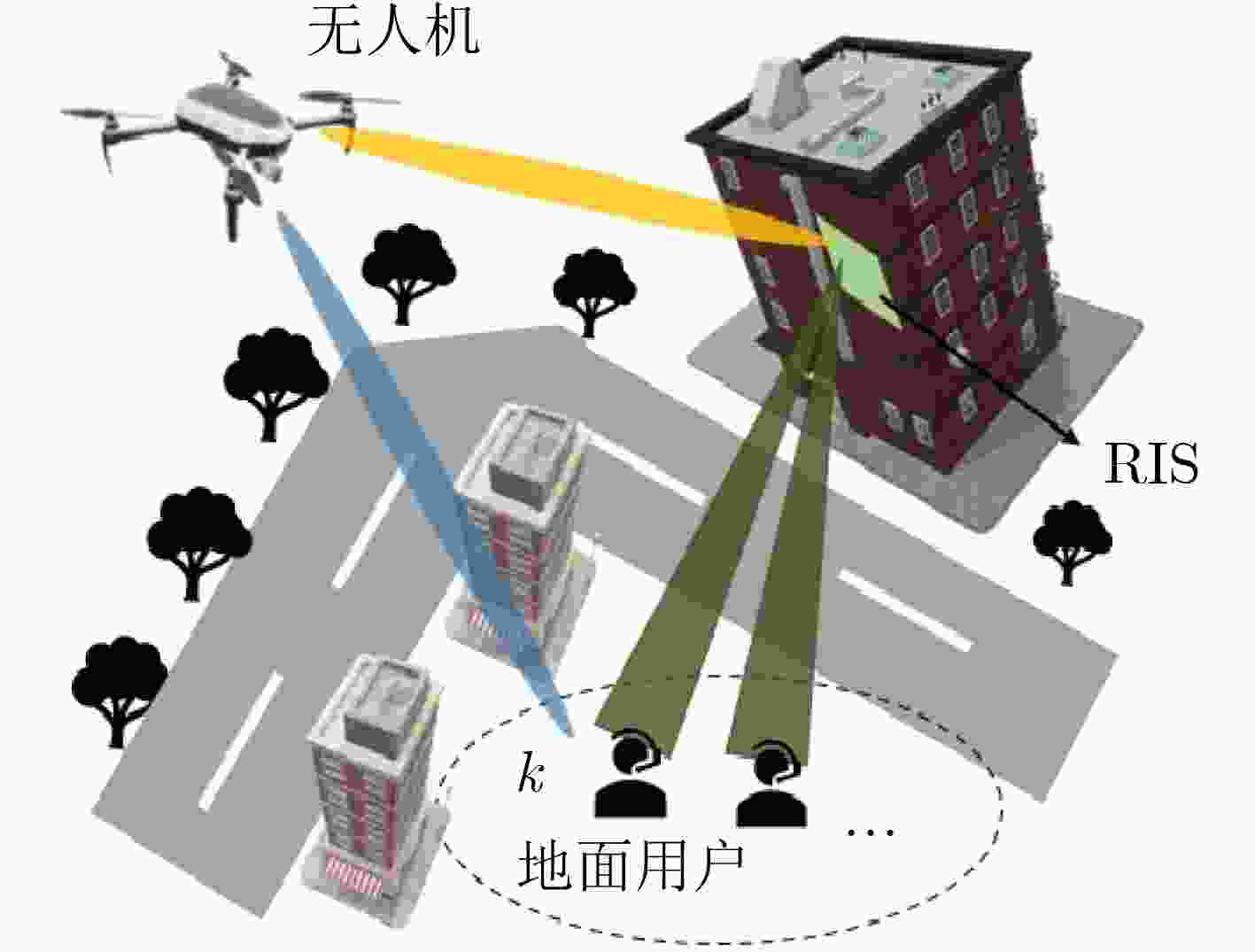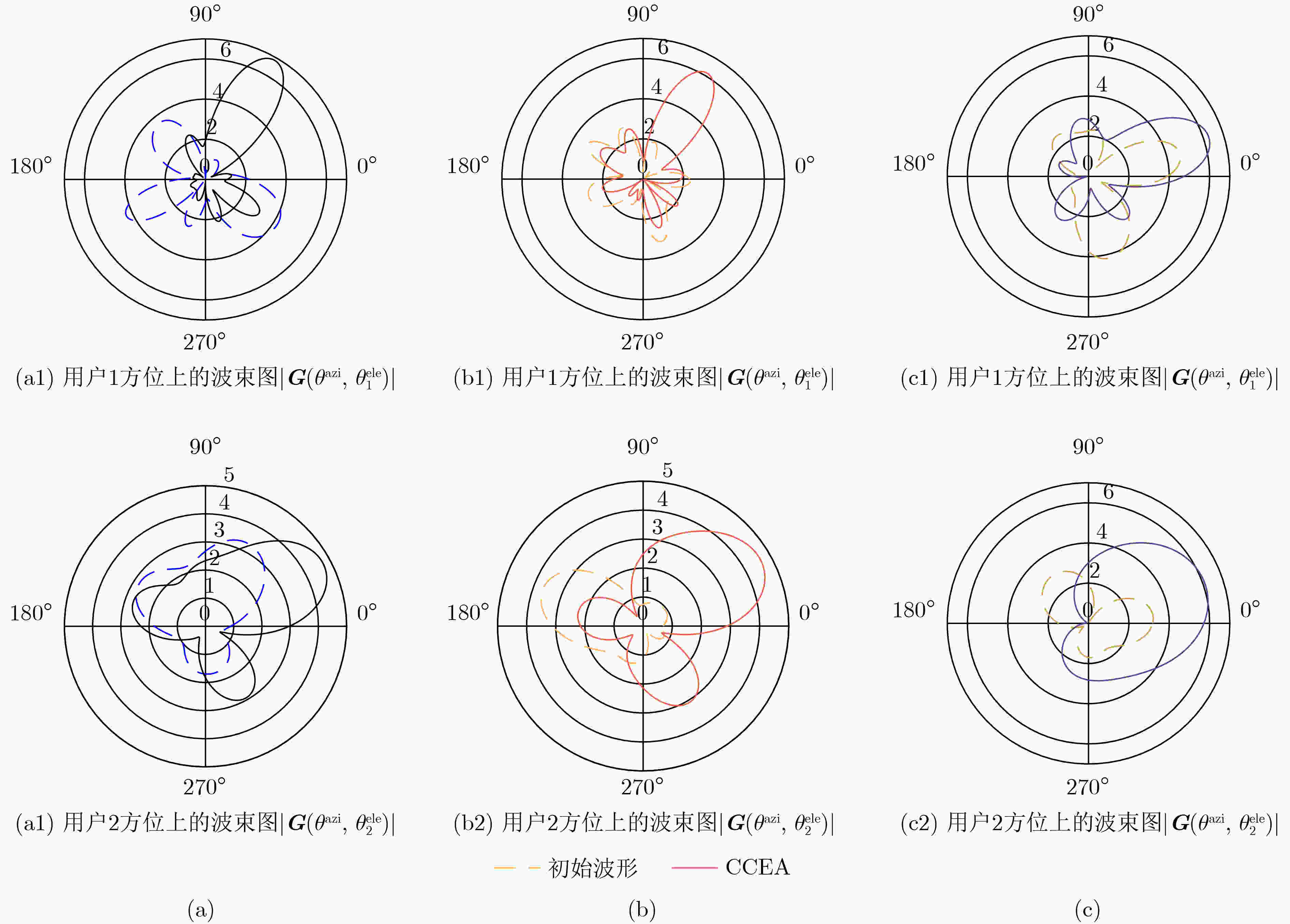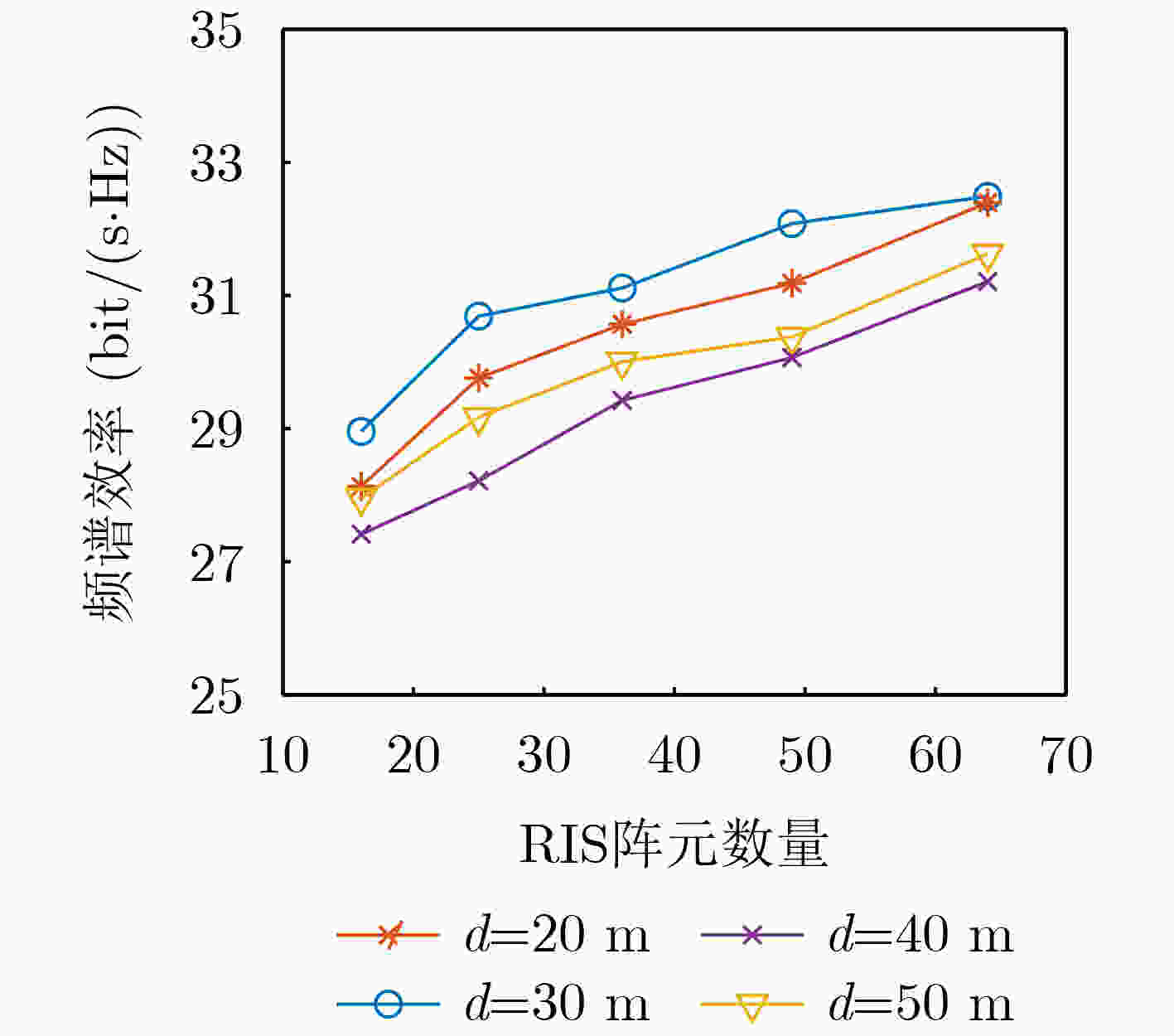A Joint Beamforming Method Based on Cooperative Co-evolutionary in Reconfigurable Intelligent Surface-Assisted Unmanned Aerial Vehicle Communication System
-
摘要: 针对传统联合波束成形方法在智能超表面(RIS)辅助无人机(UAV)通信系统优化中存在的局限性,包括针对RIS仅考虑相移矩阵优化、优化方法缺乏应用普适性等问题,该文面向RIS辅助无人机通信服务多用户场景,创新性提出一种基于合作协同进化(CCEA)的联合波束优化方法。该方法利用两个子种群的独立进化将联合波束成形问题分解成RIS反射波波束设计和发射端波束设计两个子问题进行求解,通过进化过程中的信息交互与协作来实现联合波束成形设计。数值仿真结果表明,相较于仅考虑RIS相移矩阵设计的联合波束优化,CCEA通过设计RIS反射波波束形状改变了反射波在3维空间中的能量分布,进而提升了接收端信干噪比(SINR)和频谱效率;此外,基于种群的CCEA算法能够产生更加多样的解,因此在UAV和用户的不同位置设置下均能实现反射波对用户方向的有效覆盖,相对于传统方法能够避免局部最优、具有更强的应用普适性。Abstract:
Objective: High-quality wireless communication enabled by Unmanned Aerial Vehicles (UAVs) is set to play a crucial role in the future. In light of the limitations posed by traditional terrestrial communication networks, the deployment of UAVs as nodes within aerial access networks has become a vital component of emerging technologies in Beyond Fifth Generation (B5G) and Sixth Generation (6G) communication systems. However, the presence of infrastructure obstructions, such as trees and buildings, in complex urban environments can hinder the Line-of-Sight (LoS) link between UAVs and ground users, leading to a significant degradation in channel quality. To address this challenge, researchers have proposed the integration of Reconfigurable Intelligent Surfaces (RIS) into UAV communication systems, providing an energy-efficient and flexible passive beamforming solution. RIS consists of numerous adjustable electromagnetic units, with each element capable of independently configuring various phase shifts. By adjusting both the amplitude and phase of incoming signals, RIS can intelligently reflect signals from multiple transmission paths, thereby achieving directional signal enhancement or nulling through beamforming. Given the limitations of conventional joint beamforming methods—such as their exclusive focus on optimizing the RIS phase shift matrix and lack of universality—a novel joint beamforming approach based on a Cooperative Co-Evolutionary Algorithm (CCEA) is proposed. This method aims to enhance Spectrum Efficiency (SE) in multi-user scenarios involving RIS-assisted UAV communications. Methods: The proposed approach begins by optimizing the RIS phase shift matrix, followed by the design of the beam shape for RIS-reflected waves. This process modifies the spatial energy distribution of RIS reflections to improve the Signal-to-Interference-plus-Noise Ratio (SINR) at the receiver. To address challenges in existing optimization algorithms, an Evolutionary Algorithm (EA) is introduced for the first time, and a cooperative co-evolutionary structure based on EA is developed to decouple joint beamforming subproblems. The central concept of CCEA revolves around decomposing complex problems into several subproblems, which are then solved through distributed parallel evolution among subpopulations. The evaluation of individuals within each subpopulation, representing solutions to their respective subproblems, relies on collaboration among different populations. Specifically, this involves merging individuals from one subpopulation with representative individuals from others to create composite solutions. Subsequently, the overall fitness of these composite solutions is assessed to evaluate individual performance within each subpopulation. Results and Discussions: The simulation results demonstrate that, in comparison to joint beamforming, which focuses solely on designing the RIS phase shift matrix, further optimizing the shape of the reflected beam from the RIS significantly enhances the accuracy and effectiveness of the main lobe coverage over the user's position, resulting in improved SE. Although Maximum Ratio Transmission (MRT) precoding can maximize the output SINR of the desired signal, it may also lead to considerable inter-user interference, which subsequently diminishes the SE. Therefore, the implementation of joint beamforming is essential. The optimization algorithms proposed in this paper are effective for both the actual amplitude-phase shift model and the ideal RIS amplitude-phase shift model. However, factors such as dielectric loss associated with the actual circuit structure of the RIS can attenuate the strength of the reflected wave reaching the client, thereby reducing the SINR at the receiving end and ultimately lowering the SE. Additionally, the increase in SE achievable through Deep Reinforcement Learning (DRL) and Alternating Optimization (AO) is limited when compared to CCEA. Unlike the optimization of individual action strategies employed in DRL, the CCEA algorithm produces a greater variety of solutions by utilizing crossover and mutation among individuals within the population, thereby mitigating the risk of local optimization. Moreover, CCEA can optimize the spatial distribution of the reflected waves through a more sophisticated design of the RIS reflecting beam shape. This results in an enhanced signal intensity at the receiving end, allowing for a higher SE compared to AO and DRL, which primarily focus on optimizing the RIS phase shift matrix. Conclusions: In light of the limitations observed in previous joint beamforming optimization methods, this paper introduces a novel joint beamforming optimization approach based on CCEA. This method effectively decomposes the joint beam optimization problem into two distinct sub-problems: the design of the RIS reflection beam waveform and the beamforming design at the transmitter. These sub-problems are addressed through independent parallel evolution, utilizing two separate sub-populations. Notably, for RIS passive beamforming, this approach innovatively optimizes the RIS phase shift matrix alongside the design of the RIS reflected beam shape for the first time. Numerical simulation results indicate that, compared to joint beamforming strategies that focus solely on optimizing the RIS phase shift matrix, a more meticulous design of the RIS reflected waveform can significantly alter the intensity distribution of reflected waves in 3D space. This alignment enables the reflected beam to converge on the user’s location while mitigating interference, thereby enhancing the system’s SE. Furthermore, the CCEA algorithm demonstrates the capability to achieve effective coverage of RIS reflected beams for users, regardless of varying base station and user locations. The optimization process leads to a reduction in Peak Side Lobe Level (PSLL) and an improvement in SE by at least 5 dB, showing its spatial applicability across diverse scenarios. Future research will aim to further investigate the application of evolutionary algorithms and swarm intelligence optimization techniques in joint beamforming optimization, as well as explore the potential of RIS beam waveform design to optimize communication systems, adapting to increasingly complex and diversified communication requirements. -
1 基于CCEA的RIS辅助无人机通信联合波束成形优化算法
(1)输入初始位置信息${{\boldsymbol{w}}_{\rm{U}}},{{\boldsymbol{w}}_{\rm{R}}},{{\boldsymbol{w}}_k}$和其他基本系统参数;获得
$ {{\boldsymbol{H}}_{{\mathrm{U}} {\text{-}}{\mathrm{ R}}}} $, $ {{\boldsymbol{h}}_{{\mathrm{R}}{\text{-}} k}} $, ${{\boldsymbol{h}}_{{\mathrm{U}} {\text{-}} k}}$(2)根据式(16)及式(9)生成初始子种群:
${\bf{pop}}_0^{\boldsymbol{\varPhi}} = [{{\boldsymbol{\varPhi}} _1},{{\boldsymbol{\varPhi}} _2},\cdots,{{\boldsymbol{\varPhi}} _{{\text{pop}}}}]$, $ {\bf{pop}}_0^{\boldsymbol{G}} = [{{\boldsymbol{G}}_1},{{\boldsymbol{G}}_2},\cdots,{{\boldsymbol{G}}_{{\text{pop}}}}] $(3)随机初始化两个子种群的代表解${{\boldsymbol{\varPhi}} _{{\text{best}}}}$, $ {{\boldsymbol{G}}_{{\text{best}}}} $ (4)根据式(17)计算两个子种群组合解的初始综合适应度,并将子种群中的个体根据综合适应度排序,即 $\begin{aligned} {\text{Fitnes}}{{\text{s}}_1}({\bf{pop}}_0^{\boldsymbol{\varPhi}} ;{{\boldsymbol{G}}_{{\text{best}}}}) =\;& [{\text{Fitness}}({{\boldsymbol{\varPhi}} _1},{{\boldsymbol{G}}_{{\text{best}}}}),\cdots,\\& {\text{Fitness}}({{\boldsymbol{\varPhi}} _{{\text{pop}}}},{{\boldsymbol{G}}_{{\text{best}}}})]\end{aligned}$ $\begin{aligned} {\text{Fitnes}}{{\text{s}}_2}({{\boldsymbol{\varPhi}} _{{\text{best}}}};{\bf{pop}}_0^{\boldsymbol{G}}) = \;& [{\text{Fitness}}({{\boldsymbol{\varPhi}} _{{\text{best}}}},{{\boldsymbol{G}}_1}),\cdots,\\& {\text{Fitness}}({{\boldsymbol{\varPhi}} _{{\text{best}}}},{{\boldsymbol{G}}_{{\text{pop}}}})]\end{aligned}$ (5)for i = 1, 2, ···, inter do (6) 从${\bf{pop}}_{i - 1}^{\boldsymbol{\varPhi}} $和$ {\bf{pop}}_{i - 1}^{\boldsymbol{G}} $选择${\text{pop}} \times {\text{Selectrate}}$个体作为父代 (7) if rand< 交叉概率Crossrate (8) 在两个子种群父代中随机选择个体进行染色体交叉; (9) end if (10) if rand< 突变概率Mutationrate (11) 在两个子种群的个体随机选择染色体进行突变; (12) end if (13) 得到两个子种群对应的子代种群${\bf{pop}}_i^{\boldsymbol{\varPhi}} $和$ {\bf{pop}}_i^{\boldsymbol{G}} $ (14) 利用式(17)计算组合解综合适应度:${\text{Fitnes}}{{\text{s}}_1}({\bf{pop}}_i^{\boldsymbol{\varPhi }};{{\boldsymbol{G}}_{{\text{best}}}})$
和${\text{Fitnes}}{{\text{s}}_2}({{\boldsymbol{\varPhi}} _{{\text{best}}}};{\bf{pop}}_i^{\boldsymbol{G}})$,并将得到的解按适应度降序排序;(15) if max(${\text{Fitnes}}{{\text{s}}_1}({\bf{pop}}_i^{\boldsymbol{\varPhi}} ;{{\boldsymbol{G}}_{{\text{best}}}})$)>${\text{Fitness}}({{\boldsymbol{\varPhi}} _{{\text{best}}}},{{\boldsymbol{G}}_{{\text{best}}}})$ (16) 更新${{\boldsymbol{\varPhi }}_{{\text{best}}}}$; (17) end if (18) if max(${\text{Fitnes}}{{\text{s}}_2}({{\boldsymbol{\varPhi }}_{{\text{best}}}};{\bf{pop}}_i^{\boldsymbol{G}})$)>${\text{Fitness}}({{\boldsymbol{\varPhi}} _{{\text{best}}}},{{\boldsymbol{G}}_{{\text{best}}}})$ (19) 更新$ {{\boldsymbol{G}}_{{\text{best}}}} $; (20) end if (21) 计算并更新代表解的适应度${\text{Fitness}}({{\boldsymbol{\varPhi}} _{{\text{best}}}},{{\boldsymbol{G}}_{{\text{best}}}})$ (22)end for (23)得到$[{{\boldsymbol{\varPhi}} _{{\text{best}}}},{{\boldsymbol{G}}_{{\text{best}}}}]$作为联合波束成形优化解; 表 1 系统参数
参数符号 参数值 参数符号 参数值 参数符号 参数值 参数符号 参数值 ${P_{\max }}$ 30 dBm ${\sigma ^2}$ –114 dBm f 2.4 GHz $\rho $ 0.01 ${\alpha _{{\mathrm{U}} {\text{-}} {\mathrm{R}}}}$ 2.2 ${\alpha _{{\mathrm{U}} {\text{-}} k}}$ 3.5 ${\alpha _{{\mathrm{R}} {\text{-}} k}}$ 2.8 K 2 M 4 ${L_x}$ 4 ${L_y}$ 4 $\phi $ $0.43\pi $ ${A_{\min }}$ 0.2 $\alpha $ 1.6 ${K_1}$ 10 ${K_2}$ 10 表 2 CCEA算法参数
参数名 参数值 参数名 参数值 种群个体数量pop 20 选择率 Selectrate 0.2 交叉概率 Crossrate 0.6 突变率 Mutationrate 0.1 最大迭代次数 inter 1 000 k1 0.5 c1 60 c2 1.0 表 3 图3对应的位置参数及频谱效率对比
UAV和用户位置参数 用户1方位
$[\theta _1^{{\text{azi}}},\theta _1^{{\text{ele}}}]$用户2方位
$[\theta _2^{{\text{azi}}},\theta _2^{{\text{ele}}}]$初始频谱效率
(bit/(s·Hz))优化后的频谱效率
(bit/(s·Hz))图3(a) $ {{\boldsymbol{w}}_{\rm{U}}} = {(25\,{\text{m}},30\,{\text{m}},30\,{\text{m}})^{\mathrm{T}}} $
$ {{\mathbf{w}}_1} = {(47\,m,15\,m,0\,m)^{\mathrm{T}}} $
$ {{\boldsymbol{w}}_2} = {(25\,m,5\,m,0\,m)^{\mathrm{T}}} $[59.04°, 64.99°] [30.96°, 23.21°] 6.511 7 26.868 9 图3(b) $ {{\boldsymbol{w}}_{\rm{U}}} = {(25\,{\text{m}},15\,{\text{m}},30\,{\text{m}})^{\mathrm{T}}} $
$ {{\mathbf{w}}_1} = {(47\,m,15\,m,0\,m)^{\mathrm{T}}} $
$ {{\boldsymbol{w}}_2} = {(25\,m,5\,m,0\,m)^{\mathrm{T}}} $[59.04°, 64.99°] [30.96°, 23.21°] 3.320 4 28.713 6 图3(c) $ {{\mathbf{w}}_{\rm{U}}} = {(25\,{\text{m}},30\,{\text{m}},30\,{\text{m}})^{\mathrm{T}}} $
$ {{\boldsymbol{w}}_1} = {(30\,m,15\,m,0\,m)^{\mathrm{T}}} $
$ {{\boldsymbol{w}}_2} = {(5\,m,5\,m,0\,m)^{\mathrm{T}}} $[36.67°, 26.36°] [6.30°, 15.47°] 6.234 8 27.642 8 -
[1] ZENG Yong, ZHANG Rui, and LIM T J. Wireless communications with unmanned aerial vehicles: Opportunities and challenges[J]. IEEE Communications Magazine, 2016, 54(5): 36–42. doi: 10.1109/MCOM.2016.7470933. [2] 朱秋明, 华博宇, 毛开, 等. 无人机毫米波信道建模进展和挑战[J]. 数据采集与处理, 2020, 35(6): 1049–1059. doi: 10.16337/j.1004-9037.2020.06.004.ZHU Qiuming, HUA Boyu, MAO Kai, et al. Advances and challenges of UAV millimeter-wave channel modeling[J]. Journal of Data Acquisition and Processing, 2020, 35(6): 1049–1059. doi: 10.16337/j.1004-9037.2020.06.004. [3] 朱秋明, 倪浩然, 华博宇, 等. 无人机毫米波信道测量与建模研究综述[J]. 移动通信, 2022, 46(12): 2–11. doi: 10.3969/j.issn.1006-1010.20221114-0001.ZHU Qiuming, NI Haoran, HUA Boyu, et al. A survey of UAV millimeter-wave channel measurement and modeling[J]. Mobile Communications, 2022, 46(12): 2–11. doi: 10.3969/j.issn.1006-1010.20221114-0001. [4] PANG Xiaowei, SHENG Min, ZHAO Nan, et al. When UAV meets IRS: Expanding air-ground networks via passive reflection[J]. IEEE Wireless Communications, 2021, 28(5): 164–170. doi: 10.1109/MWC.010.2000528. [5] WU Qingqing and ZHANG Rui. Intelligent reflecting surface enhanced wireless network via joint active and passive beamforming[J]. IEEE Transactions on Wireless Communications, 2019, 18(11): 5394–5409. doi: 10.1109/TWC.2019.2936025. [6] MA Dong, DING Ming, and HASSAN M. Enhancing cellular communications for UAVs via intelligent reflective surface[C]. 2020 IEEE Wireless Communications and Networking Conference (WCNC), Seoul, Korea (South), 2020: 1–6. doi: 10.1109/WCNC45663.2020.9120632. [7] LIU Xin, YU Yingfeng, PENG Bao, et al. RIS-UAV enabled worst-case downlink secrecy rate maximization for mobile vehicles[J]. IEEE Transactions on Vehicular Technology, 2023, 72(5): 6129–6141. doi: 10.1109/TVT.2022.3231376. [8] NA Zhenyu, LIU Yue, SHI Jingcheng, et al. UAV-supported clustered NOMA for 6G-enabled internet of things: Trajectory planning and resource allocation[J]. IEEE Internet of Things Journal, 2021, 8(20): 15041–15048. doi: 10.1109/JIOT.2020.3004432. [9] NA Zhenyu, JI Chenglan, LIN Bin, et al. Joint optimization of trajectory and resource allocation in secure UAV relaying communications for internet of things[J]. IEEE Internet of Things Journal, 2022, 9(17): 16284–16296. doi: 10.1109/JIOT.2022.3151105. [10] YE Jia, QIAO Jingping, KAMMOUN A, et al. Nonterrestrial communications assisted by reconfigurable intelligent surfaces[J]. Proceedings of the IEEE, 2022, 110(9): 1423–1465. doi: 10.1109/JPROC.2022.3169690. [11] HUANG Chongwen, MO Ronghong, and YUEN C. Reconfigurable intelligent surface assisted multiuser MISO systems exploiting deep reinforcement learning[J]. IEEE Journal on Selected Areas in Communications, 2020, 38(8): 1839–1850. doi: 10.1109/JSAC.2020.3000835. [12] 万诗晴, 仲伟志, 何艺, 等. 基于深度强化学习的可重构智能超表面辅助无人机通信联合波束成形与轨迹优化[J]. 电波科学学报, 2024, 39(4): 722–731. doi: 10.12265/j.cjors.2023233.WAN Shiqing, ZHONG Weizhi, HE Yi, et al. The optimization of beamforming and trajectory for reconfigurable intelligent surface assisted UAV communication system based on deep reinforcement learning[J]. Chinese Journal of Radio Science, 2024, 39(4): 722–731. doi: 10.12265/j.cjors.2023233. [13] DANG Jian, ZHANG Zaichen, LI Yewei, et al. Fast and arbitrary beam pattern design for RIS-assisted terahertz wireless communication[J]. IEEE Transactions on Vehicular Technology, 2023, 72(2): 2620–2625. doi: 10.1109/TVT.2022.3209669. [14] RAJAGOPALAN H and RAHMAT-SAMII Y. Loss quantification for microstrip reflectarray: Issue of high fields and currents[C]. 2008 IEEE Antennas and Propagation Society International Symposium, San Diego, USA, 2008: 1–4. doi: 10.1109/APS.2008.4619755. [15] ABEYWICKRAMA S, ZHANG Rui, WU Qingqing, et al. Intelligent reflecting surface: Practical phase shift model and beamforming optimization[J]. IEEE Transactions on Communications, 2020, 68(9): 5849–5863. doi: 10.1109/TCOMM.2020.3001125. [16] SAREMI S, MIRJALILI S, and LEWIS A. Biogeography-based optimisation with chaos[J]. Neural Computing and Applications, 2014, 25(5): 1077–1097. doi: 10.1007/s00521-014-1597-x. [17] 何艺, 仲伟志, 万诗晴, 等. 智能反射面辅助的MU-MISO车联网毫米波通信联合波束赋形[J]. 信号处理, 2024, 40(2): 336–344. doi: 10.16798/j.issn.1003-0530.2024.02.011.HE Yi, ZHONG Weizhi, WAN Shiqing, et al. Joint beamforming for IRS-aided MU-MISO millimeter wave communication of vehicular network[J]. Journal of Signal Processing, 2024, 40(2): 336–344. doi: 10.16798/j.issn.1003-0530.2024.02.011. -






 下载:
下载:





 下载:
下载:
